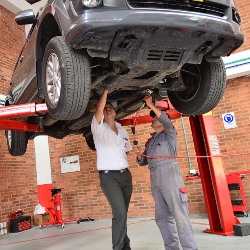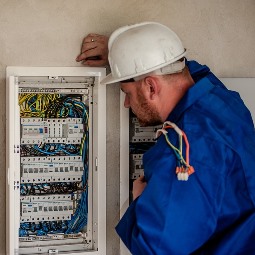How to Select the Best Trade School Training near Manilla Iowa
 Choosing to begin a new occupation and enroll in a vocational school near Manilla IA are serious decisions that will profoundly impact your long term career. But with so many trade schools to select from, exactly how do you go about identifying the ideal one? Not only do you have to make certain that you will receive the complete training needed to be successful in your new occupation, but also that the school is highly regarded and reputable. Many students make the error of choosing a trade school simply because the campus is nearest to their residence or where the work. Or they might be attracted to the one that charges the lowest tuition. Naturally the cost and location of the programs are critical considerations when evaluating vocational school options, but they should not be the sole ones. Added variables such as reputation and accreditation of the schools are important also. So prior to beginning your evaluations and comparing trade schools, you will need to know what questions to ask in order to get the information to make a final selection. We will address a few of those questions shortly in this post. But first, let’s talk about a few of the vocation options that are offered as well as the availability of online programs.
Choosing to begin a new occupation and enroll in a vocational school near Manilla IA are serious decisions that will profoundly impact your long term career. But with so many trade schools to select from, exactly how do you go about identifying the ideal one? Not only do you have to make certain that you will receive the complete training needed to be successful in your new occupation, but also that the school is highly regarded and reputable. Many students make the error of choosing a trade school simply because the campus is nearest to their residence or where the work. Or they might be attracted to the one that charges the lowest tuition. Naturally the cost and location of the programs are critical considerations when evaluating vocational school options, but they should not be the sole ones. Added variables such as reputation and accreditation of the schools are important also. So prior to beginning your evaluations and comparing trade schools, you will need to know what questions to ask in order to get the information to make a final selection. We will address a few of those questions shortly in this post. But first, let’s talk about a few of the vocation options that are offered as well as the availability of online programs.
Trade School Program Options near Manilla IA
 There are an abundance of trades to pick from in vocational schools that provide gratifying and good paying careers. Possibly you have already chosen one that you have for years desired to pursue. For instance, maybe you have always taken pleasure in working on your car and have thought about using that skill to make a living as an automotive tech. Or perhaps a family member has had a prosperous career in a specific vocation or trade and you would like to follow in her or his footsteps. No matter what your inspiration is for going into a trade, there is probably a program offered that will provide the training that you need. Following is merely a modest representation of the vocational training programs that are offered in the Manilla IA area.
There are an abundance of trades to pick from in vocational schools that provide gratifying and good paying careers. Possibly you have already chosen one that you have for years desired to pursue. For instance, maybe you have always taken pleasure in working on your car and have thought about using that skill to make a living as an automotive tech. Or perhaps a family member has had a prosperous career in a specific vocation or trade and you would like to follow in her or his footsteps. No matter what your inspiration is for going into a trade, there is probably a program offered that will provide the training that you need. Following is merely a modest representation of the vocational training programs that are offered in the Manilla IA area.
- Automotive Technician
- Heating and Cooling (HVAC) Tech
- Plumbing
- Electrician
- Welder
- Truck Driving
- Aircraft Maintenance Tech
- Lab Tech
- Construction Management
Each of the programs will have varying costs and completion times depending on the trade, type of credential and school. Some of the programs may be completed in a few weeks, while others will call for several months or even 2 or more years of training. Each of these factors must be taken into account prior to selecting a trade and a school.
Click Here to Get Free Information on Trade Schools Near You!
Learning a Vocation Online
 Trade Schools online have become very popular with Manilla IA students and increasingly more accredited programs are being offered. Even though online learning is a readily available and practical way to obtain a degree or certificate, it might not be the best option for all trades or vocations. For instance, learning to drive a semi truck is not something that you can do online, nor is training how to weld. These are skills that need to be mastered through practical training and by doing it, not by reading about it or watching videos. But certain aspects of the training can be suitable for online classes, for example learning driving and safety regulations for trucking schools or learning about metallurgy or how to read blueprints for welder schools. Many programs will incorporate online education with on campus lab work, for example for electrician or welding schools. So it is essential to ask before choosing an online program for any vocation if there is a suitable amount of hands-on training allocated to the syllabus. One way to help ensure that a vocational school program is both appropriate for online education and provides in-depth practical training is to verify that it’s accredited by a nationally recognized accrediting agency (more on accreditation later). For those vocations that are appropriate for training online, it can be a convenient way for individuals with limited time to acquire a new trade.
Trade Schools online have become very popular with Manilla IA students and increasingly more accredited programs are being offered. Even though online learning is a readily available and practical way to obtain a degree or certificate, it might not be the best option for all trades or vocations. For instance, learning to drive a semi truck is not something that you can do online, nor is training how to weld. These are skills that need to be mastered through practical training and by doing it, not by reading about it or watching videos. But certain aspects of the training can be suitable for online classes, for example learning driving and safety regulations for trucking schools or learning about metallurgy or how to read blueprints for welder schools. Many programs will incorporate online education with on campus lab work, for example for electrician or welding schools. So it is essential to ask before choosing an online program for any vocation if there is a suitable amount of hands-on training allocated to the syllabus. One way to help ensure that a vocational school program is both appropriate for online education and provides in-depth practical training is to verify that it’s accredited by a nationally recognized accrediting agency (more on accreditation later). For those vocations that are appropriate for training online, it can be a convenient way for individuals with limited time to acquire a new trade.
What to Ask Trade School Programs
 As soon as you have chosen the vocation and type of certificate or degree that you want to obtain, either on campus or online, you can start to narrow down your list of schools. As you are probably aware, there are many vocational schools in the Manilla IA area and across the United States to choose from. That’s why it is extremely important to have a list of key qualifications when making school assessments. As previously stated in our opening paragraph, location and tuition will most likely be the first two factors you will look at. Following are several additional ones that you should research before enrolling in your school of choice.
As soon as you have chosen the vocation and type of certificate or degree that you want to obtain, either on campus or online, you can start to narrow down your list of schools. As you are probably aware, there are many vocational schools in the Manilla IA area and across the United States to choose from. That’s why it is extremely important to have a list of key qualifications when making school assessments. As previously stated in our opening paragraph, location and tuition will most likely be the first two factors you will look at. Following are several additional ones that you should research before enrolling in your school of choice.
Accreditation. Numerous Manilla IA area trade programs have earned either a regional or a national accreditation. They may acquire Institutional Accreditation, which involves the school’s programs as a whole, or Programmatic Accreditation, which pertains to an individual program, for example HVAC technology. Verify that the school is accredited by a U.S. Department of Education approved accrediting agency, for instance the Accreditation Board for Engineering and Technology. Along with helping make certain that you acquire an excellent education, it may help in obtaining financial aid or student loans, which are in many cases unavailable for non-accredited schools. Additionally, some states mandate that the training course be accredited in order to be approved for licensing where applicable.
How Long in Operation? One clue to help measure the quality of a trade school near Manilla IA is how long it has been in operation. A poorly rated or a fly by night school typically will not stay in business very long, so longevity is a big plus. Having said that, even the top schools had to start from their first day of training, so consider it as one of multiple qualifications.
Completion Rates. Ask the trade schools you are considering what their completion rates are. The completion rate is the percentage or portion of students who enroll in and complete the program. A low completion rate could suggest that students were disappointed with the program and dropped out. It may also signify that the teachers were not competent to train the students. It’s also important that the schools have high job placement rates. Older and/or more reputable schools may have a more extensive list of graduates, which may produce more contacts for the school to use for their apprenticeship and job placement programs. A high job placement rate will not only validate that the school has an excellent reputation within the industry, but also that it has the network of contacts to help students secure apprenticeships or employment in the Manilla IA area.
Apprenticeship Programs. Numerous trade programs are taught together with an internship or an apprenticeship program. Those participating trade and vocational programs will help place you in an apprenticeship program within their network of contractors or labor unions. Find out if the schools you are comparing have referring relationships with Manilla IA area specialists in the trade. An apprenticeship not only provides a rewarding experience by supplying hands-on training, but it also furnishes employment opportunities and helps to establish relationships in the local professional community.
Modern Facilities. Confirm that the campus facilities and the tools that you will be trained on are state-of-the-art and what you will be working with in the field. If you are presently in an internship or an apprenticeship, check with the tech you are working under regarding what you should be expecting. Otherwise, ask a local Manilla IA contractor if they can give you some suggestions. Additionally bear in mind that unless you are able to relocate, the school needs to be within commuting distance of your residence. Remember that if you decide to attend an out-of-state school, besides the added moving costs there may be increased tuition charges compared to in-state residents.
Smaller Classes. It’s desirable that you receive as much one-on-one instruction as possible, which can be challenging in bigger classes. Ask if you can sit in on a couple of the classes so that you can observe how big they are and witness first hand the interaction between instructors and students. Speak with some of the students and get their comments concerning class sizes and instruction. Last, speak with a few of the teachers and find out what their level of experience is in Iowa and what certifications or degrees they have earned.
Flexible Scheduling. Make sure that the class schedules for the schools you are evaluating are flexible enough to fulfill your needs. If you are only able to attend classes in the evening or on weekends near Manilla IA, check that the programs you are looking at offer those choices. If you can only attend on a part-time basis, make sure that the school you select allows part-time enrollment. Additionally, ask what the protocol is to make-up classes should you miss any because of work, illness or family emergencies.
Mechanic School Manilla Iowa
 Enrolling in the ideal trade school near Manilla IA is a crucial first step toward a fulfilling career in the vocation of your choice. As we have discussed in this post, you need to choose a technical school and a degree or certificate program that are both accredited and have outstanding reputations within the profession. Other features to search for are ample practical training and state-of-the-art facilities. You need to check out each of the schools in person that you are most interested in to explore the campus and talk with both the faculty and current students. Try to get a feel for the quality of the instruction and the interaction between them. Additionally, ask about scheduling choices and whether or not night or weekend classes are available if needed. And remember to inquire about financial assistance and student loan options too. You initially came to this website because of your interest in Mechanic School and wanting more information on the topic Trade Schools For HVAC. However, if you ask the appropriate questions as we have detailed in our checklist for assessing schools, you’ll be able to narrow down your options so that you can make an educated decision. With the appropriate training, hard work and dedication, you can eventually become a licensed professional in your chosen trade.
Enrolling in the ideal trade school near Manilla IA is a crucial first step toward a fulfilling career in the vocation of your choice. As we have discussed in this post, you need to choose a technical school and a degree or certificate program that are both accredited and have outstanding reputations within the profession. Other features to search for are ample practical training and state-of-the-art facilities. You need to check out each of the schools in person that you are most interested in to explore the campus and talk with both the faculty and current students. Try to get a feel for the quality of the instruction and the interaction between them. Additionally, ask about scheduling choices and whether or not night or weekend classes are available if needed. And remember to inquire about financial assistance and student loan options too. You initially came to this website because of your interest in Mechanic School and wanting more information on the topic Trade Schools For HVAC. However, if you ask the appropriate questions as we have detailed in our checklist for assessing schools, you’ll be able to narrow down your options so that you can make an educated decision. With the appropriate training, hard work and dedication, you can eventually become a licensed professional in your chosen trade.
Other Iowa Hard Working Locations
Manilla, Iowa
Manilla is located at 41°53′18″N 95°13′58″W / 41.88833°N 95.23278°W / 41.88833; -95.23278 (41.888202, -95.232809).[5] According to the United States Census Bureau, the city has a total area of 1.03 square miles (2.67 km2), all of it land.[1]
As of the census[2] of 2010, there were 776 people, 337 households, and 214 families residing in the city. The population density was 753.4 inhabitants per square mile (290.9/km2). There were 369 housing units at an average density of 358.3 per square mile (138.3/km2). The racial makeup of the city was 97.9% White, 0.1% Asian, 1.2% from other races, and 0.8% from two or more races. Hispanic or Latino of any race were 2.6% of the population.
There were 337 households of which 27.0% had children under the age of 18 living with them, 49.9% were married couples living together, 8.9% had a female householder with no husband present, 4.7% had a male householder with no wife present, and 36.5% were non-families. 33.5% of all households were made up of individuals and 18.1% had someone living alone who was 65 years of age or older. The average household size was 2.18 and the average family size was 2.74.
